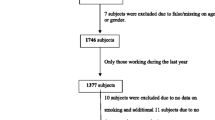Abstract
Objective: To assess the health effects of transferral to low-exposure jobs on subjects with occupational asthma (OA). Methods: We performed a cross-sectional survey of 83 workers in 2 platinum (Pt) refineries and 2 catalyst production plants, all with diagnosed OA due to Pt salts. In all, 9 workers (group A; 11%) continued to be exposed at the time of examination, 16 subjects (group B; 19%) had been transferred to other workplaces within the production building, 39 subjects (group C; 47%) had been transferred to areas outside the building but inside the plant, and 19 subjects (group D; 23%) had left the plant. The median period from transferral to examination was 54 months (lower quartile 23 months, upper quartile 84 months, n = 74). Symptoms, skin-prick tests (SPT) with environmental allergens and Pt salt, total serum IgE, lung function, and bronchial hyperresponsiveness were assessed by standard procedures. Results: Asthma symptoms were reported by all subjects in the production area but by only 37 of 74 subjects (50%) after transferral, with no difference being found between groups B, C, and D. Both the proportion of subjects sensitized to Pt salts (100%, 88%, 67%, and 42% in groups A, B, C, and D, respectively) and the degree of sensitization were associated with exposure (P < 0.0002). Total IgE was higher in group A as compared with groups B, C, or D (P < 0.002). There was no association between bronchial hyperresponsiveness and exposure. Although no univariate difference in FEV1 was found between the groups, regression analysis showed an association between FEV1 and exposure (P < 0.002). In all, 13 subjects demonstrated a predicted FEV1 value of <80% (22%, 6%, 10%, and 32% in groups A, B, C, and D, respectively). They were older (median 49 versus 37 years; P < 0.002) and had worked over longer periods in high-exposure areas in spite of symptoms (median 43 versus 10 months; P < 0.003). Fifteen subjects of groups C or D had been removed from areas B previously, eight of them due to respiratory symptoms. Conclusions: For the majority of subjects with OA due to Pt salts transfer to low exposure areas as defined in this study may not be associated with a more unfavorable outcome as compared with complete removal from exposure sources.
Similar content being viewed by others
Author information
Authors and Affiliations
Additional information
Received: 16 April 1998 / Accepted: 3 September 1998
Rights and permissions
About this article
Cite this article
Merget, R., Schulte, A., Gebler, A. et al. Outcome of occupational asthma due to platinum salts after transferral to low-exposure areas. Int Arch Occup Environ Health 72, 33–39 (1999). https://doi.org/10.1007/s004200050331
Issue Date:
DOI: https://doi.org/10.1007/s004200050331




